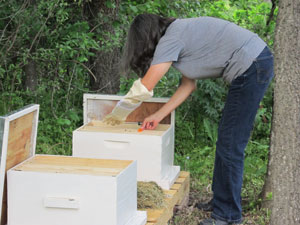I've learned a lot about chickens during the 2 ½ years that
I’ve been raising them. The biggest thing I’ve learned is that there’s a lot to
learn! This week I wanted to share with you some fascinating (at least to me)
things I've learned about hens.
First of all, as I mentioned in a previous blog, young hens
(called pullets when they’re less than one year old) do not start laying until
they are 5 or 6 months old. And when they start laying, it’s anything but
regular. A newly laying pullet might produce one small egg or a strangely
colored egg every few days; I've even had pullets whose first 5 or 6 eggs were
laid without a shell. So it takes a while for the pullets to get good at
egg-laying.
Once they are mature layers, each hen will lay, on average,
one egg every 25 hours. So the laying time for an individual hen shifts to one
hour later each day, until they would be laying in the early evening. At that
point, they normally hold off laying until the next morning, and then the one
egg every 25 hour schedule starts up again.
Have you ever wondered what makes the yolk of an egg yellow?
As I’m sure we’re all aware, the skin of most chickens is somewhat yellow, and
this is due to a considerable amount of pigment, which comes from green feeds
and yellow corns. In addition to coloring the chicken’s skin yellow, this pigment
also gives the egg yolk its yellow color. Free-range chickens, such as mine,
have plenty of access to green feeds and thus tend to lay eggs which are a richer
color of yellow than hens raised in factory farms.
Over time, however, the pigment stored in the hen’s body is
used up. And it is used in a particular sequence. So you can look at a hen, and tell how many eggs she's laid. The pigment is first
bleached out of the vent (rear part of the hen where the egg comes out),
followed by her earlobe, beak, and feet.
So while in my flock I have a mix of pullets and hens
ranging in age from 1-3 years, I can easily tell the youngest from the oldest
by how bleached out they are.
While the rate of egg-laying is greatest in the hen’s first
year or two, a healthy hen can actually lay eggs for 10-12 years. She may not
lay many eggs, perhaps only one every 3 or 4 days, after the age of 4, but she
will still be laying.
Most hens, unfortunately, never reach old age. Hens raised
in factory farms lay for a year or two and then are culled (a nice way to say
killed), when the cost of their feed exceeds the income generated from their
egg-laying.
My hens, on the other hand, don’t have anything to worry
about. I am committed to keeping them as long as they are healthy and happy,
regardless of how many eggs they lay.
Next blog I’ll tell you why I have a totally different
attitude towards roosters.











